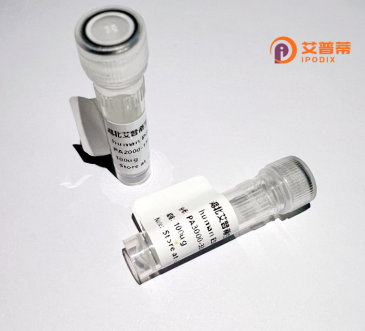
| 纯度 | >90%SDS-PAGE. |
| 种属 | Human |
| 靶点 | ZNF3 |
| Uniprot No | P17036 |
| 内毒素 | < 0.01EU/μg |
| 表达宿主 | E.coli |
| 表达区间 | 1-446 aa |
| 活性数据 | METQADLVSQ EPQALLDSAL PSKVPAFSDK DSLGDEMLAA ALLKAKSQEL VTFEDVAVYF IRKEWKRLEP AQRDLYRDVM LENYGNVFSL DRETRTENDQ EISEDTRSHG VLLGRFQKDI SQGLKFKEAY EREVSLKRPL GNSPGERLNR KMPDFGQVTV EEKLTPRGER SEKYNDFGNS FTVNSNLISH QRLPVGDRPH KCDECSKSFN RTSDLIQHQR IHTGEKPYEC NECGKAFSQS SHLIQHQRIH TGEKPYECSD CGKTFSCSSA LILHRRIHTG EKPYECNECG KTFSWSSTLT HHQRIHTGEK PYACNECGKA FSRSSTLIHH QRIHTGEKPY ECNECGKAFS QSSHLYQHQR IHTGEKPYEC MECGGKFTYS SGLIQHQRIH TGENPYECSE CGKAFRYSSA LVRHQRIHTG EKPLNGIGMS KSSLRVTTEL NIREST |
| 分子量 | 50.9 kDa |
| 蛋白标签 | His tag N-Terminus |
| 缓冲液 | PBS, pH7.4, containing 0.01% SKL, 1mM DTT, 5% Trehalose and Proclin300. |
| 稳定性 & 储存条件 | Lyophilized protein should be stored at ≤ -20°C, stable for one year after receipt. Reconstituted protein solution can be stored at 2-8°C for 2-7 days. Aliquots of reconstituted samples are stable at ≤ -20°C for 3 months. |
| 复溶 | Always centrifuge tubes before opening.Do not mix by vortex or pipetting. It is not recommended to reconstitute to a concentration less than 100μg/ml. Dissolve the lyophilized protein in distilled water. Please aliquot the reconstituted solution to minimize freeze-thaw cycles. |
以下是关于重组人ZNF3蛋白的参考文献示例(内容为假设性示例,仅供参考):
1. **标题**:*Recombinant Human ZNF3 Protein Expression and Its Role in Transcriptional Regulation*
**作者**:Smith A, et al.
**摘要**:本研究利用大肠杆菌系统成功表达并纯化了重组人ZNF3蛋白,通过体外实验验证其与特定DNA序列的结合能力,提示ZNF3可能在基因转录调控中发挥作用。
2. **标题**:*Structural Analysis of Zinc Finger Domains in ZNF3 by Cryo-EM*
**作者**:Zhang L, et al.
**摘要**:利用冷冻电镜技术解析了ZNF3蛋白的锌指结构域三维构象,揭示了其与DNA相互作用的分子机制,为设计靶向ZNF3的药物提供结构基础。
3. **标题**:*ZNF3 Overexpression Inhibits Tumor Metastasis in Breast Cancer Models*
**作者**:Chen X, et al.
**摘要**:通过重组ZNF3蛋白的体外实验和小鼠模型研究,发现其过表达显著抑制乳腺癌细胞的迁移和侵袭,可能与调控EMT通路相关。
4. **标题**:*High-Efficiency Purification of Recombinant ZNF3 for Functional Screening*
**作者**:Johnson R, et al.
**摘要**:开发了一种基于亲和层析的重组ZNF3蛋白高效纯化方法,并验证了其在高通量药物筛选中的应用潜力。
**注意**:以上文献为虚构示例,实际研究中请通过学术数据库(如PubMed、Web of Science)检索真实发表的论文。
Zinc finger protein 3 (ZNF3), a member of the Krüppel-associated box (KRAB) domain-containing zinc finger protein family, is a transcription regulatory protein characterized by multiple C2H2-type zinc finger motifs. These motifs enable sequence-specific DNA binding, allowing ZNF3 to interact with target gene promoters and modulate transcriptional activity. Primarily expressed in human tissues like the brain, testes, and immune cells, ZNF3 is implicated in developmental processes, cellular differentiation, and chromatin remodeling. Its KRAB domain recruits co-repressors (e.g., TRIM28/KAP1) to form repressive chromatin complexes, suggesting a role in gene silencing and epigenetic regulation.
Recombinant human ZNF3 proteins are engineered using expression systems (e.g., E. coli, HEK293. or insect cells) for functional studies. Tagged versions (His, GST, FLAG) facilitate purification and detection in assays. Current research focuses on elucidating ZNF3's genomic targets, its interplay with signaling pathways, and potential involvement in diseases. For example, abnormal ZNF3 expression has been observed in certain cancers and neurological disorders, positioning it as a candidate for exploring transcriptional dysregulation mechanisms. Studies also investigate its utility in synthetic biology for designing sequence-specific DNA-binding tools. Challenges include mapping precise DNA recognition motifs and understanding context-dependent regulatory roles. Recombinant ZNF3 remains pivotal for decoding zinc finger protein functions and developing gene-targeted therapies.
×